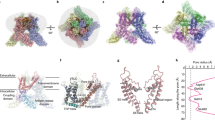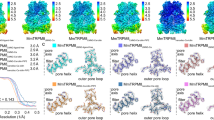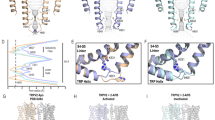Abstract
Transient receptor potential vanilloid (TRPV) channels are activated by ligands and heat and are involved in various physiological processes. In contrast to the architecturally related voltage-gated cation channels, TRPV1 and TRPV2 subtypes possess another activation gate at the selectivity filter that can open widely enough to permeate large organic cations. Despite recent structural advances, the mechanism of selectivity filter gating and permeation for both metal ions and large molecules by TRPV1 or TRPV2 is not well known. Here, we determined two crystal structures of rabbit TRPV2 in its Ca2+-bound and resiniferatoxin (RTx)- and Ca2+-bound forms, to 3.9 Å and 3.1 Å, respectively. Notably, our structures show that RTx binding leads to two-fold symmetric opening of the selectivity filter of TRPV2 that is wide enough for large organic cation permeation. Combined with functional characterizations, our studies reveal a structural basis for permeation of Ca2+ and large organic cations in TRPV2.
This is a preview of subscription content, access via your institution
Access options
Access Nature and 54 other Nature Portfolio journals
Get Nature+, our best-value online-access subscription
$29.99 / 30 days
cancel any time
Subscribe to this journal
Receive 12 print issues and online access
$189.00 per year
only $15.75 per issue
Buy this article
- Purchase on Springer Link
- Instant access to full article PDF
Prices may be subject to local taxes which are calculated during checkout







Similar content being viewed by others
References
Ramsey, I. S., Delling, M. & Clapham, D. E. An introduction to TRP channels. Annu. Rev. Physiol. 68, 619–647 (2006).
Julius, D. TRP channels and pain. Annu. Rev. Cell Dev. Biol. 29, 355–384 (2013).
Nilius, B. & Voets, T. TRP channels: a TR(I)P through a world of multifunctional cation channels. Pflugers Arch. 451, 1–10 (2005).
Venkatachalam, K. & Montell, C. TRP channels. Annu. Rev. Biochem. 76, 387–417 (2007).
Dhaka, A., Viswanath, V. & Patapoutian, A. Trp ion channels and temperature sensation. Annu. Rev. Neurosci. 29, 135–161 (2006).
Liu, B. & Qin, F. Use dependence of heat sensitivity of vanilloid receptor TRPV2. Biophys. J. 110, 1523–1537 (2016).
Caterina, M. J. et al. The capsaicin receptor: a heat-activated ion channel in the pain pathway. Nature 389, 816–824 (1997).
Long, S. B., Campbell, E. B. & Mackinnon, R. Crystal structure of a mammalian voltage-dependent Shaker family K+ channel. Science 309, 897–903 (2005).
Lenaeus, M. J. et al. Structures of closed and open states of a voltage-gated sodium channel. Proc. Natl Acad.Sci. USA 114, E3051–E3060 (2017).
Holmgren, M., Shin, K. S. & Yellen, G. The activation gate of a voltage-gated K+ channel can be trapped in the open state by an intersubunit metal bridge. Neuron 21, 617–621 (1998).
Yellen, G. The moving parts of voltage-gated ion channels. Q. Rev. Biophys. 31, 239–295 (1998).
Hackos, D. H., Chang, T. H. & Swartz, K. J. Scanning the intracellular S6 activation gate in the shaker K+ channel. J. Gen. Physiol. 119, 521–532 (2002).
Xie, C., Zhen, X. G. & Yang, J. Localization of the activation gate of a voltage-gated Ca2+ channel. J. Gen. Physiol. 126, 205–212 (2005).
Cao, E., Liao, M., Cheng, Y. & Julius, D. TRPV1 structures in distinct conformations reveal activation mechanisms. Nature 504, 113–118 (2013).
Munns, C. H., Chung, M. K., Sanchez, Y. E., Amzel, L. M. & Caterina, M. J. Role of the outer pore domain in transient receptor potential vanilloid 1 dynamic permeability to large cations. J. Biol. Chem. 290, 5707–5724 (2015).
Chung, M. K., Güler, A. D. & Caterina, M. J. TRPV1 shows dynamic ionic selectivity during agonist stimulation. Nat. Neurosci. 11, 555–564 (2008).
Puopolo, M. et al. Permeation and block of TRPV1 channels by the cationic lidocaine derivative QX-314. J. Neurophysiol. 109, 1704–1712 (2013).
Chen, J. et al. Pore dilation occurs in TRPA1 but not in TRPM8 channels. Mol. Pain 5, 3 (2009).
Ferreira, L. G. & Faria, R. X. TRPing on the pore phenomenon: what do we know about transient receptor potential ion channel-related pore dilation up to now? J. Bioenerg. Biomembr. 48, 1–12 (2016).
Nabissi, M., Morelli, M. B., Santoni, M. & Santoni, G. Triggering of the TRPV2 channel by cannabidiol sensitizes glioblastoma cells to cytotoxic chemotherapeutic agents. Carcinogenesis 34, 48–57 (2013).
Banke, T. G., Chaplan, S. R. & Wickenden, A. D. Dynamic changes in the TRPA1 selectivity filter lead to progressive but reversible pore dilation. Am. J. Physiol. Cell Physiol. 298, C1457–C1468 (2010).
Li, H., Wang, S., Chuang, A. Y., Cohen, B. E. & Chuang, H. H. Activity-dependent targeting of TRPV1 with a pore-permeating capsaicin analog. Proc. Natl Acad.Sci. USA 108, 8497–8502 (2011).
Li, M., Toombes, G. E., Silberberg, S. D. & Swartz, K. J. Physical basis of apparent pore dilation of ATP-activated P2X receptor channels. Nat. Neurosci. 18, 1577–1583 (2015).
Samways, D. S., Tomkiewicz, E., Langevin, O. M. & Bukhari, M. Measurement of relative Ca2+ permeability during sustained activation of TRPV1 receptors. Pflugers Arch. 468, 201–211 (2016).
Brenneis, C. et al. Bupivacaine-induced cellular entry of QX-314 and its contribution to differential nerve block. Br. J. Pharmacol. 171, 438–451 (2014).
Binshtok, A. M. et al. Coapplication of lidocaine and the permanently charged sodium channel blocker QX-314 produces a long-lasting nociceptive blockade in rodents. Anesthesiology 111, 127–137 (2009).
Bean, B. P. Pore dilation reconsidered. Nat. Neurosci. 18, 1534–1535 (2015).
Zhou, M., Morais-Cabral, J. H., Mann, S. & MacKinnon, R. Potassium channel receptor site for the inactivation gate and quaternary amine inhibitors. Nature 411, 657–661 (2001).
Choi, K. L., Aldrich, R. W. & Yellen, G. Tetraethylammonium blockade distinguishes two inactivation mechanisms in voltage-activated K+ channels. Proc. Natl Acad.Sci. USA 88, 5092–5095 (1991).
Mitcheson, J. S., Chen, J., Lin, M., Culberson, C. & Sanguinetti, M. C. A structural basis for drug-induced long QT syndrome. Proc. Natl Acad.Sci. USA 97, 12329–12333 (2000).
Liao, M., Cao, E., Julius, D. & Cheng, Y. Structure of the TRPV1 ion channel determined by electron cryo-microscopy. Nature 504, 107–112 (2013).
Zubcevic, L. et al. Cryo-electron microscopy structure of the TRPV2 ion channel. Nat. Struct. Mol. Biol. 23, 180–186 (2016).
Huynh, K. W. et al. Structure of the full-length TRPV2 channel by cryo-EM. Nat. Commun. 7, 11130 (2016).
Zhang, F. et al. Engineering vanilloid-sensitivity into the rat TRPV2 channel. eLife 5, e16409 (2016).
Yang, F., Vu, S., Yarov-Yarovoy, V. & Zheng, J. Rational design and validation of a vanilloid-sensitive TRPV2 ion channel. Proc. Natl Acad.Sci. USA 113, E3657–E3666 (2016).
Gao, Y., Cao, E., Julius, D. & Cheng, Y. TRPV1 structures in nanodiscs reveal mechanisms of ligand and lipid action. Nature 534, 347–351 (2016).
McGoldrick, L. L. et al. Opening of the human epithelial calcium channel TRPV6. Nature 553, 233–237 (2018).
Chugunov, A. O., Volynsky, P. E., Krylov, N. A., Nolde, D. E. & Efremov, R. G. Temperature-sensitive gating of TRPV1 channel as probed by atomistic simulations of its trans- and juxtamembrane domains. Sci. Rep. 6, 33112 (2016).
Matthies, D. et al. Cryo-EM structures of the magnesium channel CorA reveal symmetry break upon gating. Cell 164, 747–756 (2016).
Hite, R. K. & MacKinnon, R. Structural titration of Slo2.2, a Na+-dependent K+ channel. Cell 168, 390–399.e311 (2017).
Saotome, K., Singh, A. K., Yelshanskaya, M. V. & Sobolevsky, A. I. Crystal structure of the epithelial calcium channel TRPV6. Nature 534, 506–511 (2016).
Foadi, J. et al. Clustering procedures for the optimal selection of data sets from multiple crystals in macromolecular crystallography. Acta Crystallogr. D Biol. Crystallogr. 69, 1617–1632 (2013).
McCoy, A. J. et al. Phaser crystallographic software. J. Appl. Crystallogr. 40, 658–674 (2007).
Emsley, P. & Cowtan, K. Coot: model-building tools for molecular graphics. Acta Crystallogr. D Biol. Crystallogr. 60, 2126–2132 (2004).
Adams, P. D. et al. PHENIX: a comprehensive Python-based system for macromolecular structure solution. Acta Crystallogr. D Biol. Crystallogr. 66, 213–221 (2010).
Hayward, S. & Lee, R. A. Improvements in the analysis of domain motions in proteins from conformational change: DynDom version 1.50. J. Mol. Graph. Model. 21, 181–183 (2002).
Winn, M. D. et al. Overview of the CCP4 suite and current developments. Acta Crystallogr. D Biol. Crystallogr. 67, 235–242 (2011).
Delano, W.L. The PyMOL Molecular Graphics System (DeLano Scientific, 2002).
Acknowledgements
Data were collected at Northeastern Collaborative Access Team (NE-CAT) beamline 24-ID-C and Southeast Regional Collaborative Access Team (SER-CAT) beamline 22-ID in the Advanced Photon Source. We thank Yang Zhang for assistance with the imaging experiments and data analysis. This work was supported by NIH R35 NS097241 (S.-Y.L.), NIH R00 NS086916 (H.Y.) and NIH DP2 GM126898 (H.Y.). Beamline 24-ID-C is funded by P41GM103403 and S10 RR029205 and APS is supported by the U.S. Department of Energy under Contract No. W-31-109-Eng-38.
Author information
Authors and Affiliations
Contributions
L.Z. crystallized the protein and solved the structures under the guidance of S.-Y.L., S.L. carried out all electrophysiological experiments under the guidance of H.Y., S.-Y.L., L.Z., S.L. and H.Y. wrote the paper. All authors discussed the results and commented on the manuscript.
Corresponding author
Ethics declarations
Competing interests
The authors declare no competing interests.
Additional information
Publisher’s note: Springer Nature remains neutral with regard to jurisdictional claims in published maps and institutional affiliations.
Integrated supplementary information
Supplementary Figure 1 Sequence alignment TRPV1 and TRPV2.
Red arrows mark N- and C-terminal deletions, and red shaded box indicates deletion in the turret for the TRPV2 construct (miTRPV2) used for structural studies. Asterisks indicate point mutations introduced to render TRPV2 sensitive to RTx. ARD, Ankyrin Repeat Domain; PH, pore helix; SF, selectivity filter; PL, pore loop; CTD, C-terminal Domain.
Supplementary Figure 2 Functional characterization of TRPV2 constructs.
a,b, Representative whole-cell recordings from HEK293T cells expressing TRPV2QM (n = 14), miTRPV2QM (n = 9) and miTRPV2 (n = 3) in response to RTx (repeated voltage ramps from −60 mV to +60 mV at 5 s intervals). The blue bar indicates application of 50 nM RTx, and the red bar 200 μM ruthenium red. a stands for basal currents, b for stationary RTx-evoked currents, and c for RuR-inhibited currents. c-d, Representative whole-cell recordings of TRPV2 WT (n = 4), TRPV2QM (n = 12) and miTRPV2QM (n = 5) in response to 2-APB (c) from repeated voltage ramps from -120 mV to + 120 mV at 5 s intervals (d). The red bar indicates application of 2 mM 2-APB. Characters: a stands for basal currents, b for stationary 2-APB-induced currents, and c for currents after 2-APB washout. e-f, Representative RTx-evoked current traces of TRPV2QM and miTRPV2QM from inside-out recordings from control experiments (e) or in the presence of extracellular 200 μM RuR (pipette solution) (f). g, Quantification of inhibition of inward currents by RuR as quantified by the ratios of peak current amplitudes at -120 mV and + 120 mV. The number of patches is noted in parentheses. Data are presented as mean ± s.e.m. (****p < 0.0001, two-tailed unpaired Student’s t-test. p-values for TRPV2QM and miTRPV2QM are both p < 0.0001). h, YO-PRO-1 dye uptake by HEK293T cells expressing wtTRPV2 (n = 7 cells), TRPV2QM (n = 10 cells) and non-transfected cells (n = 8 cells). YO-PRO-1 uptake was triggered by application of 2 mM 2-APB (black arrow).
Supplementary Figure 3 Model building of \({\rm{miTRPV2}}_{{\rm{Ca}}^{2+}}\).
a,b, Anomalous difference Fourier maps for selenium was calculated to 5 Å and contoured to 1.5 σ. a, Selenium peaks in the \({\rm{miTRPV2}}_{{\rm{Ca}}^{2+}}\) tetramer. Methionine residues are shown in stick representation. b, Close-up views of the ARD. c-g, 2Fo-Fc electron density (light blue mesh, contoured at 1 σ) in the \({\rm{miTRPV2}}_{{\rm{Ca}}^{2+}}\) channel (blue, cartoon and stick representation). Some side chains are labelled for orientation. c, Segments of the ankyrin repeat domain. d, The TRP domain and the CTD. e, Helices S2, S3 and the S2-S3 linker. f, Pore forming helices S5, S6. g, The pore helix.
Supplementary Figure 4 2Fo-Fc electron density coverage in the \({\rm{miTRPV2}}_{{\rm{RTx,Ca}}^{2+}}\) channel.
2Fo-Fc electron density is contoured at 1 σ and shown in light blue mesh. Some bulky residues are labelled for orientation. a, Ankyrin repeats 1-6. b, The TRP domain and CTD. c, S6 and S5 helices of subunit A and B. d, Pore helices of subunit A and B. e, Unassigned density in the cavity of \({\rm{miTRPV2}}_{{\rm{RTx,Ca}}^{2+}}\). The 2Fo-Fc density contoured at 1.5 σ and the \({\rm{miTRPV2}}_{{\rm{RTx,Ca}}^{2+}}\) is shown in red cartoon and the side chains are displayed in stick representation. The putative calcium ions are shown as green spheres. Side view of the channel cavity with subunits A and C removed for ease of viewing.
Supplementary Figure 5 π-helices in the S4-S5 linker determine the quaternary structure of the subunits and the conformation of the pore helices.
a, A rotation of the \({\rm{miTRPV2}}_{{\rm{Ca}}^{2+}}\) subunit A (blue) around its π-helix hinge places it in alignment with the subunit A of \({\rm{miTRPV2}}_{{\rm{RTx,Ca}}^{2+}}\) (red) (Cα r.m.s.d. 0.99 Å). Conformational changes are identified in the S4-S5 linker (right panel, boxed region). To illustrate the conformational change an insert shows a 90° rotated view of the region. b, A side view of the overlay of \({\rm{miTRPV2}}_{{\rm{RTx,Ca}}^{2+}}\) subunits A (red) and B (pale cyan) (Cα r.m.s.d. 0.51 Å) illustrates the presence of local changes in the S4-S5 linker and a difference in the angle of the pore helices (dashed line boxes). c, Front view of the overlay showing the pore forming S5, S6 and pore helices. A ~5° change in the tilt of the pore helix was measured. d, RTx bound to subunit A is shown in maroon stick representation, and RTx bound to subunit B is shown in slate blue sticks. e,f, Simulated Annealing Omit Fo-Fc map of RTx. SA Fo-Fc omit map was calculated at full resolution (45-3.1 Å) with an annealing temperature of 3000 K, contoured at 2.8 σ and displayed as green mesh. e, RTx molecule (magenta sticks) bound to subunit A. f, RTx molecule (magenta sticks) bound to subunit B.
Supplementary Figure 6 Comparison of the \({\rm{miTRPV2}}_{{\rm{RTx,Ca}}^{2+}}\) (red) with miTRPV2EM (green).
a, Top view, alignment illustrates the contraction of the \({\rm{miTRPV2}}_{{\rm{RTx,Ca}}^{2+}}\) channel along the y-axis (subunits B and D), and widening along the x-axis (subunits A and C). The differences in distance between subunits B and D and A and C of \({\rm{miTRPV2}}_{{\rm{RTx,Ca}}^{2+}}\) and miTRPV2EM were measured between Cα atoms of N429 residues in S2 (not shown). b, Alignment of subunits B of \({\rm{miTRPV2}}_{{\rm{RTx,Ca}}^{2+}}\) (red) and miTRPV2EM (green) (Cα r.m.s.d. 0.61 Å). While the VSLD align well, there is a conformational difference in the S4-S5 linker and the pore helix (dashed boxes). c, A close-up view of the S4-S5 linkers. d, A front view of the aligned subunits, showing S5, S6 and the pore helix. e, Bottom-up view of the common gate. TRPV2EM (green) and \({\rm{miTRPV2}}_{{\rm{RTx,Ca}}^{2+}}\) (red). For simplicity, only S6 helices are shown. Compared to TRPV2EM, S6 helices of \({\rm{miTRPV2}}_{{\rm{RTx,Ca}}^{2+}}\) splayed open slightly more.
Supplementary Figure 7 Structural changes elicited by RTx binding and intersubunit interactions.
a, Side view of the overlay of the \({\rm{miTRPV2}}_{{\rm{Ca}}^{2+}}\) (marine) and \({\rm{miTRPV2}}_{{\rm{RTx,Ca}}^{2+}}\) (red) subunits C and B, with RTx shown in stick and sphere representation and colored in magenta. The RTx molecule bound in this configuration is not able to exert force on the π-helix hinge, and therefore cannot cause the subunit B to rotate. b, Hydrogen bond networks around the pore helix in subunit B of \({\rm{miTRPV2}}_{{\rm{Ca}}^{2+}}\). A network of hydrogen bonds is present at the Y542-T602-Y627 triad. c, Hydrogen bonds around the miTRPV2EM pore helix. No hydrogen bonds are present between the triad residues Y542-T602-Y627.
Supplementary Figure 8 The mutation T602A reduced the permeability of TRPV2 channel towards the large cation NMDG+.
a,b, Representative inside-out recordings of TRPV2QM (a) and TRPV2QM T602A (b) in symmetrical 150 mM NaCl (blue trace) or in 150 mM external NaCl/150 mM internal NMDG-Cl (red trace). Currents were evoked by intracellular application of 50 nM RTx. c, The shift in Erev induced by replacing internal NaCl with equimolar NMDG-Cl was calculated by subtracting the Erev of NMDG+ by the Erev of symmetrical Na+. For each recording, the Erev of NMDG+ was calculated from the average of five NMDG+ current traces after the shift in Erev stabilized. d, The permeability ratios PNMDG/PNa of TRPV2QM and TRPV2QM T602A were calculated from the Erev shifts determined in c. The number of recordings is noted in parentheses. Data are presented as mean ± s.e.m. p** < 0.01, two-tailed unpaired Student’s t-test. p-values: c, 0.0057; d, 0.0094.
Supplementary information
Rights and permissions
About this article
Cite this article
Zubcevic, L., Le, S., Yang, H. et al. Conformational plasticity in the selectivity filter of the TRPV2 ion channel. Nat Struct Mol Biol 25, 405–415 (2018). https://doi.org/10.1038/s41594-018-0059-z
Received:
Accepted:
Published:
Issue Date:
DOI: https://doi.org/10.1038/s41594-018-0059-z
This article is cited by
-
Molecular details of ruthenium red pore block in TRPV channels
EMBO Reports (2024)
-
Structural titration reveals Ca2+-dependent conformational landscape of the IP3 receptor
Nature Communications (2023)
-
A pentameric TRPV3 channel with a dilated pore
Nature (2023)
-
Structural mechanisms of TRPV2 modulation by endogenous and exogenous ligands
Nature Chemical Biology (2023)
-
Cannabinoid non-cannabidiol site modulation of TRPV2 structure and function
Nature Communications (2022)



